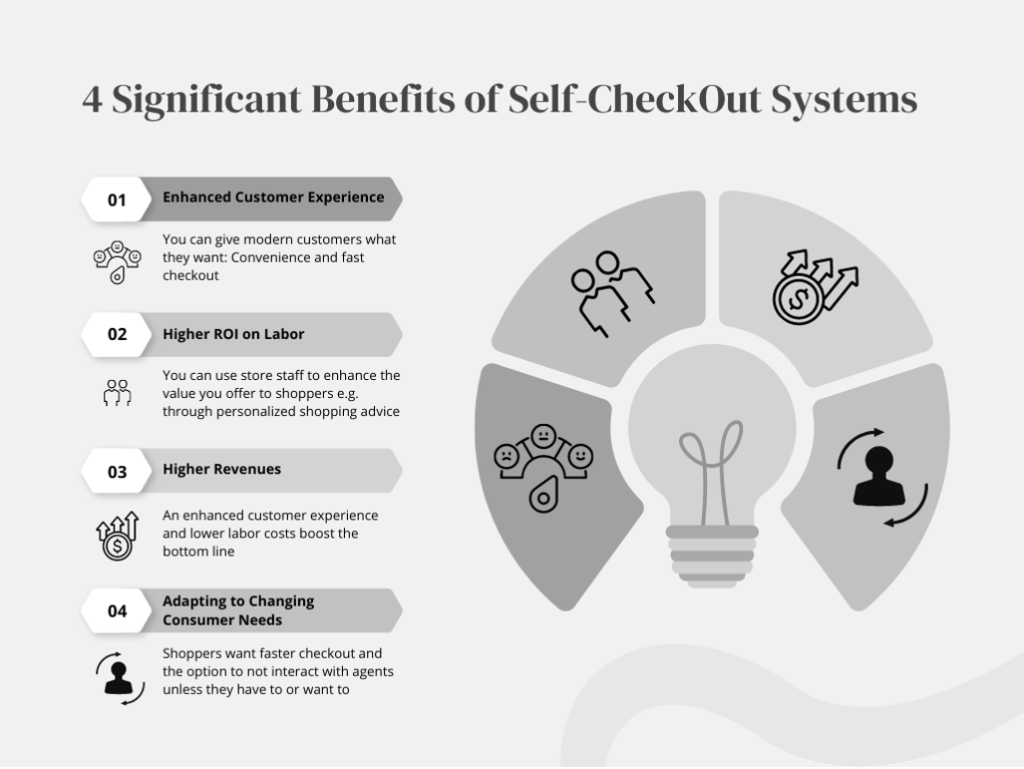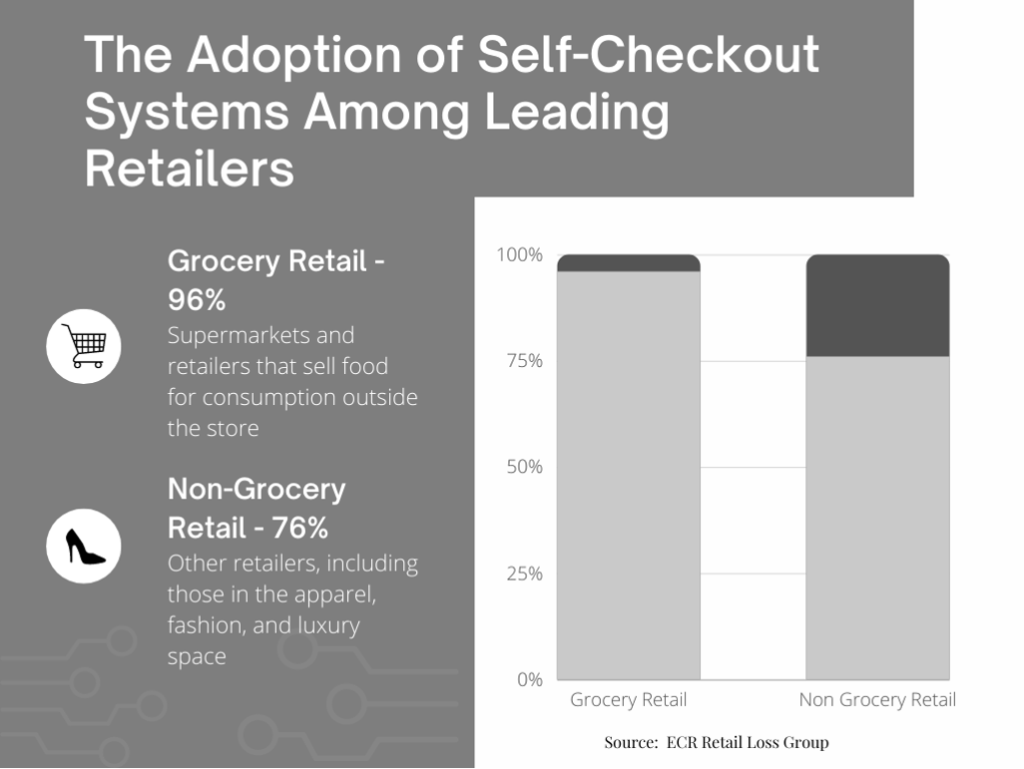An Evaluation Of Retail Self-Checkout Systems
One of the biggest challenges facing brick-and-mortar retail stores is how to stay relevant and successful in a world where customers can stay home and conveniently order from Amazon.
E-commerce giants have been experiencing resounding success in recent years, and many people took this trend to spell doom for physical stores. However, as premier consulting firm McKinsey points out, brick-and-mortar stores are here to stay.
But even though consumers continue to use physical stores, their priorities have changed.
Some time ago, shoppers valued interactions with helpful and friendly store agents. Now, they value convenience and checkout speed. Such insights are important as it’s more essential than ever for stores to build an awesome customer experience. Consumer behavior reports state that 90% of customers are more likely to return to physical stores that give them positive experiences.
Self-checkout systems as a part of retail checkout systems are a growing trend in retail, and if you haven’t adopted them, you’re probably considering it. But are they worth it for your store? Should you treat them as a priority? Will smart carts and self-checkout help you give consumers what they value most in retail stores: convenience and speed?
How Do Consumers Feel About Retail Self-Checkout Systems?
The retail landscape has changed dramatically over the past few years. A significant portion of the change is due to the COVID-19 pandemic, which disrupted norms and accelerated technology adoption.
The pandemic forced many consumers to use technology like contactless payment systems for the first time. Granted, consumers won’t continue doing everything they were forced to do during the pandemic. Research has shown that what they adopt will depend on how much satisfaction they got from the forced experiences.
More Shoppers Are Now Open to Self-Checkout Systems in Retail
Interestingly, according to McKinsey, 70% of those who used self-checkout (SCO systems) during the pandemic will use them again.
The landscape surrounding SCO systems has continued to shift — their adoption by retail stores is more likely to be received favorably by shoppers. In 2017 or thereabouts, very few consumers would have gone to a store and chosen to use an SCO system over the normal way of checking out with the help of an agent. Back then, adopting such systems might have pushed customers away. But things are different now — SCO systems are more acceptable.
But being likable isn’t enough. Useful innovation must help the bottom line.
Let's Talk
Can Self-Checkout Systems Help Retail Stores Remain Competitive?
The COVID-19 pandemic was a trying time for physical retail stores, in no small part due to lockdowns and social-distancing requirements. While the pandemic is behind us, block-and-mortar stores aren’t in the clear.
Because of the changes brought about by e-commerce, physical stores must adapt in order to not only survive but also thrive.
Of the five areas McKinsey identified as critical to success in the new retail landscape, SCO systems can help with at least two, as we’ll show below.
Self-Checkout Systems Can Improve Customer Experience
Revenue management was one of the areas McKinsey identified as essential to retail success in the post-pandemic retail landscape. Stores must evaluate existing revenue levers to sustain and increase sales and boost gross margin.
One way retail stores can increase sales is by optimizing the customer experience. And since present-day customers value convenience and check-out speed, adopting SCO systems can significantly improve customer satisfaction in physical stores.
Self-Checkout Systems Can Help Use Labor More Efficiently and Reduce Associated Costs
Rethinking operating models to optimize cost structures and adapt to new shopper preferences is another critical area McKinsey identified.
SCO systems need less manpower. Instead of having an agent manning every checkout station, you can have a couple of agents manning multiple SCO stations. All they need to do is be there in case customers need help.
The words “in case” are very important here. Today’s consumer wants to interact with store employees only when they want or need to.
McKinsey calls this the zero desire for assistance. The modern shopper wants to interact with store agents in scenarios like comparing products to know which best suits the customer. They want the option to walk into a store and buy all they need without having to interact with anyone, and SCO systems make this possible.
From the retailer’s point of view, the employees you free up by adopting SCO systems come in handy in other activities that help you offer consumers more value.
For example, you could train your employees to make them expert product guides who offer personalized customer service when needed, like when helping a shopper choose the best outfit.
Something else you could do is use the employees to ensure that a shopper never comes in and finds that your store is out of their favorite product.
The Experience of Retailers Who Have Been Using Self-Checkout Systems
While many consider SCO systems a novel technology, they’ve been around for enough time for us to evaluate their impact on retail stores.
This section will rely on a study conducted by the ECR Retail Loss Group that attracted close to 100 respondents, 14 of whom rank among the top 20 retailers worldwide by overall sales value.
One of the study’s major findings was that SCO systems are an important part of the retail industry and that this importance is growing. The high rates of adoption are striking. 96% of respondents in grocery retail had adopted SCO systems. This figure dropped to 76% among non-grocery retailers.
Another notable finding was that adopting SCO systems isn’t all rosy and comes with a major challenge: increased retail losses as a result of the following:
- Malicious customers who try to game the SCO systems and get away with not paying for some items.
- User-driven errors, for example among users who haven’t used SCO systems before.
- System errors, for example due to bugs in the software.
- Product-associated errors. Some products are difficult to deal with in self-checkout.
However, retailers have adopted a range of interventions that are proving successful in reducing retail losses associated with SCO systems, including:
- Technology-based interventions like analytics, product weight checking, and deterrent video displays.
- Guardianship, where trained staff keep an eye on SCO stations to identify irregular and potentially malicious behavior.
- Store design, where design is used to raise the difficulty of successful malicious behavior.
- Store processes like switching off SCO stations at off-peak hours.
The study found that while no intervention is completely successful, the adoption of one or more techniques can significantly reduce SCO-related retail losses.
It’s up to a retailer to figure out the interventions that work best for them.
The Takeaway
SCO systems are worth it. Industry leaders have at least some SCO stations to avoid losing the tech-savvy demographic and to enhance convenience, for example through reduced waiting times during checkout.
Self-checkout has many advantages for retail stores, including a better customer experience and higher ROI on labor.
However, it also has disadvantages, the most notable of which is increased retail losses. Fortunately, such losses can be mitigated with a range of existing interventions, though they have varying rates of success.
All in all, SCO systems are beneficial and are here to stay.

